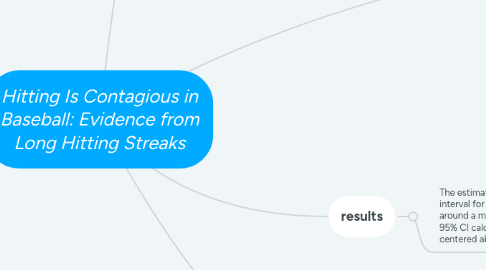
1. Introduction
1.1. Baseball folklore has long included the belief that hitting is contagious, meaning that when a batter is hitting well his production spreads like an infectious disease to other batters in the lineup. They wanted to test this idea by looking a the 46 different hitters streaks that ended at 30 games or more.
1.2. Previos Work
1.2.1. Streakiness is Sports
1.2.1.1. Multiple Test of similar ideas have back up the idea that each attempt is separate from the last, but in some sports like volley ball they did find some evidence to support streakiness, similarly other test have found a relationship between passing to people that are "hot". A study on baseball found that baseball was based more on randomness and the % chances more constant.
1.2.2. Previous Studies of Statistical Contagion
1.2.2.1. Studies have found that partners emotions can be linked from moment to moment. A study has shown that depending on how people react is linked to success like in soccer penalty shootouts
1.2.3. Homophily or social influence
1.2.3.1. In baseball the manager picks who plays in what area making the link between different than if they picked it themsefs
1.2.4. Contribution of this Reaserch
1.2.4.1. There has not been anything done similar to this and they looked to see if there is a correlation between hot batters and team success
2. Methods
2.1. Population and Sample
2.1.1. The population of the sample is all MLB players since 1945 who have a hitting streak L which is > 30 also each player must have > or = 2 AB each of their games so that they are a part of the "core lineup" of hitters. They then partition the sample into two groups: a treatment group Gt and a control group Gc. The same individuals are observed both during the hot hitter’s streak (treatment) and when the streak is not active (control) in the context of a season. They randomized the data to make sure that the era's that favored hitters or pitchers would not matter.
2.2. Box Scores Database
2.2.1. There analysis focused on 28 players streaks listed in table 1. They also split the players into groups based of the CL score or how many player stayed in the core lineup through his streak
2.3. Analysis
2.3.1. Hot Hitting Statistics
2.3.1.1. Given that they defined heat by the length of a streak, they needed a true way to define the "heat" of their streaks. To solve this issue they used the baseball heat index for the core players of a team.
2.3.2. Hypothesis Tests
2.3.2.1. The null hypothesis H0 assumed no difference between groups. In this investigation, the interpretation of the null hypothesis was that hitting is not contagious. The alternative hypothesis HA was that hitting is contagious. H0 : mean BA~0 HA : mean BA≠0 H0 : mean Q~0 HA : mean Q≠0
2.3.3. Bootstrap Confidence Intervals
2.3.3.1. They going to create a 95 percent confidence interval to see if their values are due to random chance
3. results
3.1. The estimated limits of the 95% confidence interval for this statistic are (0:0016,0:020) around a mean difference of BA~0:011. The 95% CI calculated for Q is (0:0157,0:047), centered about a mean difference Q~0:032.
4. Discussion
4.1. Our results show that for the batting average, the null hypothesis of ‘‘no difference between groups’’ is rejected at the a~0:05 level. they submit that this suggests the existence of a statistical contagion effect for hot hitting. The aggregate BA was seen to increase by 1:6 to 20 points (average of 11 percentage points) for the treatment group during a teammate’s hitting streak. The null hypothesis is also rejected for the heat index statistic Q
4.2. Batting Order Position
4.2.1. A player’s position in the batting order relative to that of the streak hitter might correlate with the quality of pitching he experiences, thereby contributing to the observed effect. They did test and found that a batters position is not an explanitory variable for hitting cognation.
4.3. Streak Recognition Delay
4.3.1. They then tested to see if there was a streak recognition delay and found that the BA contagion effect disappears when there is a delay in identification of the streak on the part of the team.
4.4. Opposing Pitching Quality
4.4.1. Another potential influencer they thought could be the abilities of the pitchers they faced but with such a large sample size it seem unlikely, but given this it is also very hard to track things such as that as their is no great way of traking pitchers abilities.
4.5. Overall Team Skill
4.5.1. A factor in this could be the ability of the teams around these players, but given that all other factors being equal, this implies that these teams did not possess uncommonly talented players as compared to their competition. Good, mediocre and bad teams experience hot hitting streaks. Therefore, overall team skill level is ruled out.
4.6. Mechanisms of Contagion
4.6.1. 4 studies point to the fact that contagion does happen.
4.7. Concluding Remarks
4.7.1. There are many other things that could be tested in the future like the influence of power hitting within this but they did not try this.

